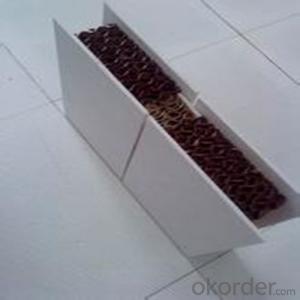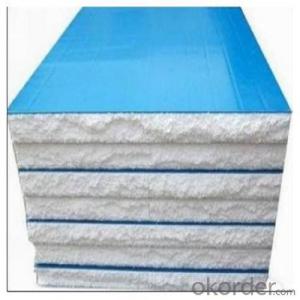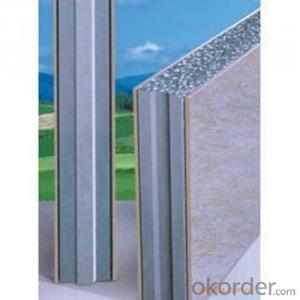Sandwich Panels in High Quality for Roof
- Loading Port:
- Tianjin
- Payment Terms:
- TT OR LC
- Min Order Qty:
- 100 m.t.
- Supply Capability:
- 5000 m.t./month
OKorder Service Pledge
OKorder Financial Service
You Might Also Like
1.Structure of Sandwich Panel
Sandwich panel is composed of 2 layers of weather-proof colored steel sheets and jetted the hard forms of polyurethane between 2 layers which feature fireproof materials. Sandwich panel is suitable for the various roofs and walls referring to the large-size factory buildings, storages, exhibition halls, gymnasiums, freezing stores, purifications workshops, etc, Sandwich panel has features temp-keeping, heat insulation, weight-bearing, weatherproof with the rich colorfulness and good appearance.
2.Main Features of the Sandwich Panel
1) Our EPS sandwich panel has the following characteristics:light dead weight, high mechanical strength, excellent shearing resistant performance, strong corrosion resistance, high durability, and weather fastness, etc.
2) The sandwich panel has excellent insulating performance: heat insulation, sound insulation, waterproof performance, etc.
3) It is easy to install and can be used many times over.
4) Nowadays, the EPS sandwich panel is widely used for cleaning workshops, industrial factory buildings, office buildings, stadiums, villas, and public buildings, etc.
5) Apart from EPS sandwich panels, Wiskind also offers rock wool sandwich panels, glass wool sandwich panels, PU sandwich panels, honeycomb sandwich panels.
6) These products have all passed ISO9001 and ISO14001 certification. Due to their high quality and low price, they are well received by our customers in Russia, Australia, Angola, Congo, and Korea, etc.
3. Sandwich Panel Images


4. Sandwich Panel l Specification
Effective width Wall panel: 950mm 1150mm 1200mm Roof panel: 950mm 980mm
Length According to customer's request
Materials Polystyrene foam board(EPS), Color steel sheet
Structure Upper and lower layer: Color steel sheet
Middle: polystyrene foam board
Thickness Color steel sheet: 0.3-0.6mm
Polystyrene foam board: 50mm 75mm 100mm 150mm 200mm
The polystyrene density 8-20kg/m3
Conventional color RAL standard
Character Light in weight, heat insulation, water resistant, green and environmental
Use various roofs and walls referring to the large size factory buildings, storages, exhibition halls, gymnasiums etc.
5.Advantages of Sandwich Panels
1) Heat and sound insulation: The outer steel sheets can maintain the lastingness of the color of the building, and reduce the solar radiation and keep the appropriate indoor temperature. The high quality heat insulation materials are made with the adoption of polyurethane PU and (PIR) polyisocyanurate resin acid hydrogen containing no Chloro-fluoro-carbons (CFC).
2) A degree inflaming retarding: This system can effectively prevent the fire and prevent the fire from spreading during the cross construction and during the use of the boards
3) Environment protection: By learning after the successful experience in environment protection constructions from companies home and abroad and through our scientific analysis, we objectively bear the idea of “low carbon designing, environmental building materials and energy-saving technology” in mind.
4) Super-low heat conductivity: The lowest heat conducting coefficient of the heat insulation boards ensures that, under the condition that the thinnest heat insulation materials are used; the system can meet the energy-saving requirement and offer the strongest basic guarantee to meet the requirement of high standard heat insulation
5) Easily and quick installation
6.FAQ
1) How to guarantee the quality of the products?
2) We have established the international advanced quality management system,every link from raw material to final product we have strict quality test;We resolutely put an end to unqualified products flowing into the market. At the same time, we will provide necessary follow-up service assurance.
3) what policy for broken parts?
4)within one year,we offer free parts. If beyond one year,you need to buy by factory cost
- Q:What are the different jointing methods for steel sheets?
- Steel sheets can be joined using various methods, depending on specific requirements and applications. Common jointing methods for steel sheets include welding, bolting, riveting, adhesive bonding, and mechanical fasteners. Welding is widely used, involving melting the steel sheet edges and joining them by applying heat and pressure. Different welding techniques, like arc welding, gas welding, or laser welding, can be used depending on the steel sheet thickness and type. Bolting involves using bolts and nuts to join steel sheets together. This method is suitable for easily disassembling or replacing joints and can be used for both permanent and temporary connections. Riveting is another method, using rivets to join steel sheets. Rivets are cylindrical metal pins inserted through holes in the sheets and deformed to secure the joint. Riveting is ideal for applications requiring high shear strength. Adhesive bonding uses specialized adhesives to join steel sheets. This method provides a strong and durable joint, suitable when welding or other mechanical jointing methods are not suitable. Adhesive bonding also distributes stress more uniformly across the joint. Mechanical fasteners, like clips, clamps, or brackets, can be used to join steel sheets. These fasteners offer a secure and reliable connection without requiring welding or other permanent jointing methods. They are commonly used when ease of assembly and disassembly is necessary. In conclusion, the choice of jointing method for steel sheets depends on factors such as the application, desired strength and durability, and ease of assembly and disassembly. Careful consideration of these factors is essential to ensure a successful and reliable connection.
- Q:What is the typical hardness range for steel sheets?
- The typical hardness range for steel sheets varies depending on the specific grade and type of steel being used. However, in general, steel sheets typically have a hardness range between 150 and 250 on the Vickers hardness scale (HV). This range provides a good balance between strength and formability, making steel sheets suitable for a wide range of applications. It is important to note that hardness can be further adjusted through various heat treatment processes to achieve specific desired properties.
- Q:Are steel sheets suitable for construction applications?
- Steel sheets are an ideal choice for construction applications due to their exceptional qualities. Renowned for their strength, durability, and versatility, steel is widely favored in the construction industry. Steel sheets find extensive use in various areas, including roofing, flooring, wall panels, structural frames, and cladding. They possess remarkable load-bearing capacity, enabling the construction of substantial and robust structures. Furthermore, steel sheets offer fire resistance, thereby enhancing the safety of buildings. Additionally, they are resilient against pests, rot, and corrosion, ensuring a prolonged lifespan for constructions. Moreover, steel sheets can be effortlessly fabricated and tailored to meet diverse construction requirements, making them a cost-effective and efficient option. In summary, steel sheets are highly suitable for construction applications due to their strength, durability, versatility, and various other advantageous properties.
- Q:What are the different manufacturing processes for steel sheets?
- There are several manufacturing processes for steel sheets, including hot rolling, cold rolling, and electro-galvanizing. Hot rolling involves heating the steel above its recrystallization temperature and then passing it through rollers to achieve the desired thickness and shape. Cold rolling, on the other hand, involves passing the steel through rollers at room temperature to further refine its thickness and surface finish. Electro-galvanizing is a process where a layer of zinc is electroplated onto the steel sheet to provide corrosion resistance. Other processes such as pickling, annealing, and coating may also be involved in the manufacturing of steel sheets.
- Q:What is the process of polishing steel sheets?
- The process of polishing steel sheets involves several steps to achieve a smooth and shiny finish. First, the steel sheets are cleaned to remove any dirt, oil, or debris that may be present on the surface. This is typically done using a degreaser or a solvent. Next, the sheets are sanded using abrasive materials, such as sandpaper or a sanding belt. This step helps to remove any visible scratches or imperfections on the surface of the steel. After sanding, the sheets are typically polished using a polishing compound or paste. This compound is applied to the surface and rubbed in with a cloth or a buffing wheel. The polishing compound helps to remove any remaining scratches and brings out the natural shine of the steel. Once the initial polishing is complete, a finer polishing compound may be used to further enhance the shine and smoothness of the steel sheets. This step is repeated until the desired level of polish is achieved. Finally, the sheets are thoroughly cleaned and inspected to ensure that they meet the desired quality standards. This may involve removing any remaining polishing compound residue and checking for any remaining imperfections. Overall, the process of polishing steel sheets requires careful cleaning, sanding, and polishing to achieve a smooth and shiny finish. The specific techniques and materials used may vary depending on the desired level of polish and the type of steel being polished.
- Q:Can steel sheets be used for wall cladding?
- Yes, steel sheets can be used for wall cladding. Steel is a highly versatile and durable material that can be used in various applications, including wall cladding. Steel sheets provide excellent structural support, weather resistance, and aesthetic appeal. They are commonly used in commercial and industrial buildings, as well as residential properties, to enhance the appearance and protect the underlying structure. Steel sheets can be customized to fit specific design requirements and are available in a variety of finishes, textures, and colors, making them a popular choice for wall cladding. Additionally, steel cladding offers several benefits such as fire resistance, low maintenance, and long-lasting performance, making it an ideal option for wall cladding in different environments.
- Q:What is the average lead time for ordering steel sheets?
- The average lead time for ordering steel sheets can vary depending on various factors such as the supplier, quantity required, customization needs, and current market conditions. However, on average, the lead time for ordering steel sheets typically ranges from a few days to several weeks. If the steel sheets are readily available in stock with the supplier, the lead time could be as short as a few days or even less, allowing for quick fulfillment of the order. However, if the steel sheets need to be sourced from a specific mill or manufacturer, the lead time can be longer. This is especially true if the order requires custom specifications, such as specific dimensions, finishes, or grades of steel. Other factors that can affect lead time include the supplier's production capacity and workload, transportation and logistics considerations, and any potential delays caused by unforeseen circumstances such as natural disasters or labor disputes. It is crucial to communicate with the supplier or manufacturer to get accurate lead time estimates for ordering steel sheets. They will be able to provide specific information based on their production capabilities and current circumstances. Additionally, it is always advisable to plan ahead and allow for some buffer time to account for any potential delays or unforeseen challenges that may arise during the ordering process.
- Q:What is the process of electroplating steel sheets?
- The process of electroplating steel sheets involves immersing the steel sheets in an electrolyte solution containing metal ions. A direct current is then passed through the solution, causing the metal ions to be deposited onto the steel sheets, forming a thin layer of metal coating. This process helps improve the steel sheets' corrosion resistance, appearance, and other desired properties.
- Q:How do you calculate the yield strength of a steel sheet?
- To calculate the yield strength of a steel sheet, you need to conduct a test called a tensile test. This test involves stretching a sample of the steel sheet until it reaches its breaking point. During the test, you measure the stress and strain applied to the sample. The yield strength is the point at which the material begins to deform plastically, meaning it does not return to its original shape after the stress is removed. It is an important mechanical property as it indicates the maximum amount of stress a material can withstand without permanent deformation. During the tensile test, you measure the stress applied to the steel sheet as you increase the strain on the sample. Stress is calculated by dividing the force applied to the sample by its original cross-sectional area. Strain is determined by dividing the change in length of the sample by its original length. The yield strength is defined as the stress at which a specific amount of permanent deformation occurs, typically 0.2% strain or 0.2% offset. This means that the yield strength is the stress required to cause a 0.2% change in length of the sample. Once you have obtained the stress-strain data from the tensile test, you can plot a stress-strain curve. The yield strength is then determined by finding the point on the curve where the stress corresponding to the specified amount of strain is reached. In summary, to calculate the yield strength of a steel sheet, you need to perform a tensile test and measure the stress and strain applied to the sample. From the stress-strain curve, you can determine the point at which a specific amount of permanent deformation occurs, which is the yield strength of the steel sheet.
- Q:What is the difference between a black and pickled steel sheet?
- The main difference between a black steel sheet and a pickled steel sheet lies in the surface finish and the process they undergo. A black steel sheet, also known as hot-rolled steel, is produced through a process called hot rolling. During this process, the steel is heated above its recrystallization temperature and passed through rollers to achieve the desired thickness. The resulting sheet has a dark, rough, and scaly surface, hence the term "black steel." The black surface is a result of the oxidation that occurs during the hot rolling process. On the other hand, a pickled steel sheet is produced through a process called pickling. After hot rolling, the black steel sheet undergoes a treatment where it is immersed in an acidic solution, typically hydrochloric acid or sulfuric acid. This pickling process removes the oxide scale from the surface of the black steel sheet, resulting in a smooth and clean surface. The pickling process also helps to improve the steel's corrosion resistance. The choice between a black steel sheet and a pickled steel sheet depends on the intended application. Black steel sheets are often preferred for structural components, such as beams and columns, where surface appearance is not a critical factor. Pickled steel sheets, with their smooth and clean surface, are commonly used in applications where a high-quality finish is required, such as automotive panels, appliances, and architectural elements. In summary, the key difference between a black steel sheet and a pickled steel sheet is the surface finish. The black steel sheet has a rough and scaly surface due to oxidation during hot rolling, while the pickled steel sheet has a smooth and clean surface after undergoing a pickling process to remove the oxide scale.
1. Manufacturer Overview |
|
|---|---|
| Location | |
| Year Established | |
| Annual Output Value | |
| Main Markets | |
| Company Certifications | |
2. Manufacturer Certificates |
|
|---|---|
| a) Certification Name | |
| Range | |
| Reference | |
| Validity Period | |
3. Manufacturer Capability |
|
|---|---|
| a)Trade Capacity | |
| Nearest Port | |
| Export Percentage | |
| No.of Employees in Trade Department | |
| Language Spoken: | |
| b)Factory Information | |
| Factory Size: | |
| No. of Production Lines | |
| Contract Manufacturing | |
| Product Price Range | |
Send your message to us
Sandwich Panels in High Quality for Roof
- Loading Port:
- Tianjin
- Payment Terms:
- TT OR LC
- Min Order Qty:
- 100 m.t.
- Supply Capability:
- 5000 m.t./month
OKorder Service Pledge
OKorder Financial Service
Similar products
New products
Hot products
Hot Searches
Related keywords






























